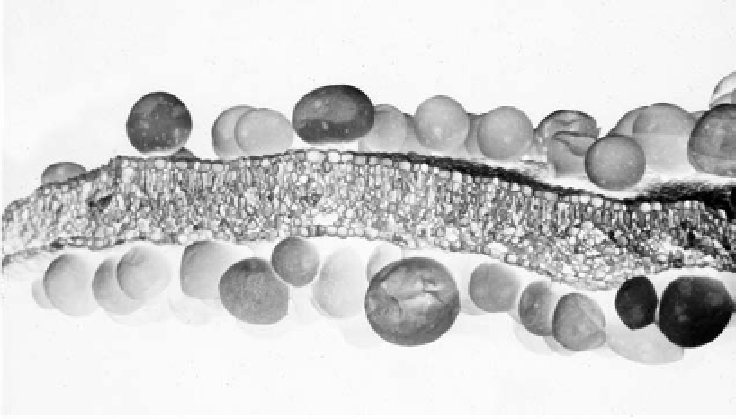Geoscience Reference
In-Depth Information
High
are less than in grasslands and sagebrush steppe, primar-
grasses and forbs are less abundant. Fires are infrequent.
Variation in plant distribution can be caused by slight
changes in topography. Playas occur in low depressions,
where water sometimes accumulates before evaporating,
leaving a dry soil surface that is white with precipitated
Salt accumulation in desert soils is a formidable prob-
lem for the survival of many plants, especially seedlings.
Most notable is that many plants cannot extract water
from soil if the salt (solute) concentration of the soil water
is higher than that of the root cells. Plants known as halo-
phytes have evolved adaptations that solve this problem
by maintaining cellular concentrations at higher levels
than those found in the soil solution. in the leaves of
some halophytes, the salt concentrations promote water
uptake that causes leaf succulence. Greasewood and red
Halophytes essentially function as pumps, collecting
salts from throughout the rooting zone and depositing
them in a smaller area as leaves fall. Some ecologists
have hypothesized that salt deposition under shrubs
might prevent the establishment of other plants nearby,
reducing competition for limited water and nutrients—
a form of allelopathy.
As in grasslands and sagebrush steppe, competition
for resources determines which desert plants and animals
manage to survive. this competition is often minimized
because of seasonal differences in activity, or because
Big sagebrush
Winterfat
Gardner's
saltbush
Shadscale
Greasewood
Pickleweed
Low
Lo
w
H
igh
SALINITY
Fig. 8.2. Distribution of six desert shrubs in relation to gradi-
ents of salinity and aridity. All are found in Wyoming except
pickleweed, the most salt-tolerant species, which is found in
Utah and nevada. Adapted from West (1988).
except for soil salinity, desert shrublands have many
features in common with sagebrush steppe: dominance
of drought-tolerant shrubs with small leaves; exten-
sive, sometimes deep root systems for obtaining water
and nutrients; sensitivity to various kinds of herbivores
and invasive plants; and processes that enhance the
efficiency of water and nutrient use, such as hydraulic
redistribution in the soil and nutrient reabsorption from
Fig. 8.3. Scanning electron micrograph
of salt-secreting glands on the leaves of
a salt-tolerant plant in the genus
Cheno-
podium.
the bulbous glands, which are
modified leaf hairs, enlarge until they
burst, after which rainwater washes
the salts onto the soil. Magnification
about 33 times. Microphotograph by
Howard c. Stutz.




Search WWH ::

Custom Search